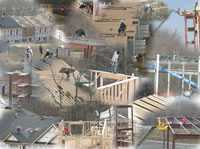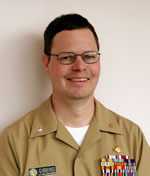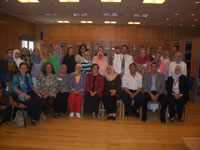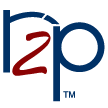NIOSH eNews
In This Issue
- From the Director’s Desk
- NIOSH Personal Dust Monitor Wins Innovation Award
- Review Set for Report on Coal Mine Dust Exposures
- Update on NIOSH Deepwater Horizon Response
- In Memoriam: Ted Stevens
- NIOSH Meeting Focuses on Respirator Manufacturers in Asia
- Popular Mechanics Highlights NIOSH Mining Activities
- Wall Street Journal Reports Safety Improvements in Commercial Fishing Industry
- Funding Supports State Occupational Injury and Illness Surveillance
- NIOSH Requests Comments on the Following:
- NIOSH Congratulates...
- News from Our Partners
Volume 8 Number 5 September 2010
From the Director’s Desk
John Howard, M.D.
Director, NIOSH
September eNews 2010
Inside NIOSH Pittsburgh
Tucked away on a hillside of the Allegheny Mountains, just a few miles south of Pittsburgh, Pennsylvania, is the NIOSH Pittsburgh Facility. It sits at the Bruceton Research Center in Bruceton, PA in what used to be a booming mining town in the late 1800’s but today is a small, mainly residential community. The Bruceton Research Center at one time was part of the U.S. Bureau of Mines, the agency created in 1910 to improve safety and health for miners in response to an alarming number of fatal explosions and fires in underground mines. Today it is home to research and technology laboratories of three Federal agencies including NIOSH. Two NIOSH units are located there, the Office of Mine Safety and Health Research (OMSHR) and the National Personal Protective Technology Laboratory (NPPTL).
In 1996, NIOSH assumed the sole federal responsibility for research on mine safety after the closure of the Bureau of Mines. NIOSH then inherited the former Bureau’s mining research laboratories in Pittsburgh, PA, and Spokane, WA. Today these two laboratories are part of OMSHR led by Dr. Jeffery Kohler.
Several recent coal mining disasters have garnered increased public attention to mining and mining research in the U.S. These incidents began in 2006 with an explosion on January 2 at the Sago Mine in West Virginia, killing 12 miners. As a result of this and several other mining disasters that followed, the Mine Improvement and New Emergency Response Act (MINER Act) was passed in 2006 (/niosh/mining/mineract
/mineract.htm).
The MINER Act charged NIOSH with developing new and existing technologies that would enhance miner safety, especially in the areas of communications and tracking, refuge alternatives, and oxygen supply. In response NIOSH established an on-going contracts and grants program in 2007 to develop and adapt safety technologies for mining applications by funding relevant research. To date communications and tracking research has focused on improving communications and tracking capabilities for both everyday and emergency use. Great strides have also been made in establishing multiple and more durable communications pathways, both hard-wired and wireless, in underground mines. Research on refuge alternatives has addressed the utility, practicality, and survivability of various refuge alternative choices, and training products have been developed for miners on the proper use of refuge alternatives. Finally, oxygen supply research has targeted new technology, standards for certification and testing, and testing of mine-deployed self-contained self-rescuers.
In 2001, the Bruceton Research Laboratory expanded when the NIOSH National Personal Protective Technology Laboratory (NPPTL) was created. The new laboratory was created when Congress emphasized the need for improved personal protective equipment and encouraged research for personal protective technologies to reduce occupational disease, injury, and death. Millions of workers in a myriad of occupations rely on personal protective equipment, such as respirators, chemical protective clothing, gloves, hearing protection, and hard hats. This includes not just miners but workers across all sectors, such as firefighters, emergency responders, and health care, agriculture, and industrial workers.
NPPTL, led by Les Boord, strives to ensure that the development of new personal protective equipment keeps pace with employer and worker needs in the increasingly diverse workforce. NPPTL research also responds to the critical need for effective protective technologies for first responders in terrorist events and other disasters. For example, by December 2001, just three months after 9/11, NPPTL had set up an active testing certification program for first responders in response to needs identified during and post 9/11. NPPTL also builds on NIOSH’s longstanding program for testing and approving respirators for use in traditional work settings to test and approve respirators for use by first responders against chemical, biological, radiological, and nuclear agents.
NPPTL’s efforts are essential for applying state-of-the-art science to meet the increasingly complex occupational safety and health challenges of the 21st Century. For example, during the 2009 H1N1 outbreak NPPTL experts provided input into policy by the Centers for Disease Control and Prevention on respirator use for healthcare workers potentially exposed to H1N1. Additionally, NPPTL developed the trusted-source web page, a one stop place for potential respirator users or purchasers to get reliable respirator information. As of January 31, 2010, the trusted-source web site was been viewed by about 10,000 unique users who viewed over 16,000 pages.
To learn more about the innovative projects and programs please visit the Office of Mine Safety and Health Research (/niosh/mining/) and National Personal Protective Technology Laboratory (/niosh/npptl/about.html)
NIOSH Personal Dust Monitor Wins Innovation Award
The NIOSH personal dust monitor was selected as one of six winners of the HHSInnovates award, presented by the U.S. Department of Health and Human Services to support a "culture of innovation" within the department. The personal dust monitor, which NIOSH developed with diverse partners, measures a miner’s cumulative exposure to respirable coal mine dust and better enables mine operators and miners to reduce miners’ risk of black lung disease. http://www.hhs.gov/news/press/2010pres/08/20100804a.html
Review Set for Report on Coal Mine Dust Exposures
NIOSH announces an outside panel of peer reviewers for a draft NIOSH current intelligence bulletin that will summarize information that has become available since 1995 about coal mine dust exposures and associated health outcomes. The peer review will help NIOSH determine if newer scientific information continues to support the conclusions and recommendations of the 1995 NIOSH criteria document on respirable coal mine dust. /niosh/review/peer/HISA/expandashealth-pr.html
Update on NIOSH Deepwater Horizon Response
In August, NIOSH posted three reports on worker safety and health issues in the Deepwater Horizon Response:
- On August 26, NIOSH issued the fifth in a series of interim reports from a health hazard evaluation of Deepwater Horizon Response workers. /niosh/topics/oilspillresponse/
- On August 18, NIOSH updated the number of Deepwater Horizon Response workers added to NIOSH’s voluntary roster. /niosh/topics/oilspillresponse/workerroster.html
- On August 13, NIOSH posted an updated report of injuries and illnesses among Deepwater Horizon Response workers, as recorded by federal Unified Area Command safety officials. /niosh/topics/oilspillresponse/data.html
In Memoriam: Ted Stevens
Former Senator Ted Stevens (R-Alaska) died in an airplane crash on August 9. Senator Stevens was a valued partner in working with NIOSH and others to address worker safety issues in Alaska, and helping to establish NIOSH’s Alaska Pacific Regional Office. The following is a clip from the 1996 video "The Unfinished Agenda: NIOSH’s First 25 years and Beyond" that includes information about workplace hazards in Alaska and a clip from Senator Stevens. http://www.youtube.com/watch?v=hDBVVP64pRQ
NIOSH Meeting Focuses on Respirator Manufacturers in Asia
The NIOSH National Personal Protective Technology Laboratory (NPPTL), in conjunction with China Medical University, conducted a manufacturers’ meeting in Taichung Taiwan. The meeting was attended by over 90 people including respirator manufacturers from six countries, occupational safety and health officials, emergency responders, and respiratory protection researchers. The meeting covered aspects of the NIOSH approval process, research on the performance and fit of N95 and EU FFP2 filtering face pieces, fitting characteristics of NIOSH N95 on Asian workers, and evaluation of protective clothing.
Popular Mechanics Highlights NIOSH Mining Activities
Popular Mechanics recently published two articles on NIOSH mining research and products:
- NIOSH evaluates next generation coal mining rescue robot. http://www.popularmechanics.com/science/energy/coal-oil-gas/next-gen-coal-mining-rescue-robot?src=rss
- NIOSH develops new headlamp for miners’ helmets that allows for better vision of dangerous rock formations. http://m.popularmechanics.com/sc/3065/
Wall Street Journal Reports Safety Improvements in Commercial Fishing Industry
Reporting on new government data about work-related fatalities, an article in the August 20 Wall Street Journal notes improvements in safety within the high-hazard commercial fishing industry and the collaborative research by NIOSH with commercial fishermen and fleet operators.
http://online.wsj.com/article/SB10001424052748704476104575439353175847106.html
Funding Supports State Occupational Injury and Illness Surveillance
NIOSH’s awards of competitive funding to state agencies support valuable work in occupational injury and illness surveillance. This year, NIOSH announced cooperative agreements with 23 states for surveillance programs, including renewals for 14 previously funded state programs and new awards to 9 additional state programs. /niosh/updates/upd-08-23-10.html
NIOSH Requests Comments on the Following
Proposed Rule on Total Inward Leakage Requirements for Respirators. Comment period extended through September 30. /niosh/docket/nioshdocket0137.html
Workers in the oil and gas extraction industry die from occupational injuries at a rate 8 times higher than the average rate for all U.S. workers. NIOSH and its partners under the National Occupational Research Agenda (NORA) invite comment on a draft blueprint for stimulating, designing, and carrying out new research to help make the industry safer.
/niosh/docket/review/docket213/pdfs/OilGasExtractionDraftAug2010.pdf
NIOSH Congratulates...

Darlene Weaver CDC Photo Contest Winner
Darlene Weaver of the NIOSH Division of Safety Research who tied for first place in the Domestic People and Program Category of the annual CDC Connects internal photo contest-showing public health in action. Weaver, a technical information specialist said "The photo is demonstrating the need to protect the health and safety of people engaged in the work environment. This displays poor examples of workplace safety." This photo along with other NIOSH photos is available on the NIOSH Flickr site http://www.flickr.com/niosh.

John Gibbins, 2010 Veterinary Responder of the Year Award
John Gibbins of NIOSH, was awarded the The Veterinary Responder of the Year at the American Veterinary Medical Association Symposium in Atlanta, Georgia, in July. Gibbins was nominated for his dedication to emergency preparedness and response. He has deployed both domestically and internationally, and has served as a critical planner, leader, and author.
News from Our Partners
New Massachusetts Law Bans Use of Lacquer Sealers in Wood Floor Finishing
Within a 10-month period in 2004-2005, three Vietnamese wood floor sanders died and three others were seriously burned in two Boston-area incidents when the lacquer sealers they were using caught fire. These deaths prompted the Massachusetts Coalition for Occupational Safety and Health (MassCOSH) and the Vietnamese-American Initiative for Development (Viet-AID) to form the Massachusetts Floor Finishing Safety Task Force, which included industry, labor, and community representatives. The Task Force proposed legislation banning use of lacquer sealers for finishing wood floors in Massachusetts. After years of advocacy, the bill was passed this legislative session and signed into law by Governor Deval Patrick on July 19. The Massachusetts Department of Public Health FACE Project and the Office of the Fire Marshall provided technical expertise to the Task Force. For more information, contact MA.FACE@state.ma.us.
Free Tools for Employers to Prevent Distracted Driving
To assist employers in communicating the dangers of distracted driving to workers and in formulating company policies on the use of mobile electronic devices, the U.S. Department of Transportation has posted free resources at http://www.distracteddriving.gov/campaign-tools/employers/ . These include a full set of materials for the 2010 Drive Safely Work Week (DSWW) campaign (part of the Network of Employers for Traffic Safety (NETS) program) in addition to supplementary posters and sample employer policies. The theme of the 2010 DSWW campaign is "Focus. Safe driving is serious business," and the materials emphasize the dangers of distracted driving, particularly the use of cell phones and texting while driving. For more information on NETS and its programs, please visit http://www.trafficsafety.org.
AOEC Clinic Participates in Centers of Occupational Health Education (COHE) Pilot
The Washington State Department of Labor & Industries has partnered with labor and business to develop four pilot Centers of Occupational Health Education (COHE) http://lni.wa.gov/ClaimsIns/Providers/Research/OHS/default.asp. One of the sites is the AOEC Member Clinic at the University of Washington—Harborview Medical Center (http://uwmedicine.washington.edu/patient-care/our-services/find-a-clinic/pages/clinic.aspx?clinicid=607). The administrators of the COHE Project report improved outcomes for injured workers by rewarding best practices in occupational health that emphasize early interventions to facilitate stakeholder communication and coordinate clinical services. For example, providers receive an enhanced service fee for claim forms submitted within 2 days of the date of injury (faster than the 1-week required by law) and for communicating with employers regarding return-to-work needs. Continuing education on this and other developments in occupational and environmental medicine is available onsite or at http://depts.washington.edu/envhlth/resources/ce.php.
Safety Video Contest for Teens Raises Job Safety Awareness
High school students across Oregon are invited to enter Oregon OSHA’s third annual safety video contest, designed to increase awareness about safety on the job for young people. Contest winners will be announced at a screening event in the spring, and winning entries will be posted on YouTube. The deadline for submissions is February 1, 2011. For more information go to http://www.orosha.org/psacontest/.
Global Happenings

Workshop participants in Cario, Egypt
This summer, Dr. Ahmed Gomaa, NIOSH; Susan Wilburn, World Health Organization (WHO); and Ginger Parker, University of Virginia; conducted a workshop attended by 60 doctors and nurses in Cairo, Egypt. The purpose of the training was to prepare leaders in healthcare to provide programming on occupational health and prevention of exposure to bloodborne infections, to evaluate and make recommendations for policy to protect healthcare workers, and to establish a regional surveillance network using the Exposure Prevention Information Network (EPINet) exposure surveillance software. The practical training included a combination of lectures, hands-on exercises, and hospital visits. For more information email agomaa@cdc.gov.
Health Hazard Evaluations (HHE)
 New Health Hazard Evaluation Report Now Available
New Health Hazard Evaluation Report Now Available
Evaluation of Chemical and Particle Exposures during Vehicle Fire Suppression Training.
The Health Hazard Evaluation (HHE) Program responded to a request to evaluate fire fighters exposures to chemicals and airborne particles during vehicle fire suppression training. Investigators found many different chemicals and high particle concentrations during the fires. Sampling results indicated that the potential exists for overexposure to formaldehyde, isocyanates, and carbon monoxide. HHE Program investigators recommend that fire fighters wear self-contained breathing apparatus until overhaul is completed. Investigators also recommend that fire fighters stand away from diesel exhaust and park fire apparatus upwind of the fires. /niosh/hhe/reports/pdfs/2008-0241-3113.pdf
NORA
NORA Award Winners Announced
NIOSH recently announced the winners of the intramural National Occupational Research Agenda (NORA) competition for FY2011. Fourteen projects received awards based on their technical and scientific merit. These proposals support moving research into practice, focusing on priority needs in the NORA sectors. For the full story, go to /niosh/updates/upd-08-02-10.html.
Save the Date! NORA 2011 Symposium
The NORA Symposium 2011 "Achieving Impact through Research and Partnerships" will be held July 12-13, 2011, at the Hilton Netherland Plaza, Cincinnati, Ohio. More information, including a call for abstracts, will be available soon. Please contact the NORA coordinator for more information noracoordinator@cdc.gov.
r2p Corner
 NIOSH Technologies Help Prevent Lead Poisoning in Nigeria
NIOSH Technologies Help Prevent Lead Poisoning in Nigeria
Recent deaths among Nigerian children mining and processing gold (in some cases by hand) from lead-bearing ore bodies triggered Doctors without Borders to seek NIOSH assistance (www.cdc.gov/mmwr/PDF/wk/mm5927.pdf, p. 846). NIOSH was asked to provide lead decontamination wipes.Upon this request NIOSH facilitated with licensing partners to donate the decontamination wipes to help prevent future lead exposure in persons living and working in these remote villages. For more information on the lead wipes contact Eric Esswein at eje1@cdc.gov.
What’s new on the NIOSH Science Blog?
State-based Occupational Safety and Health Surveillance
Occupational health surveillance-the tracking of occupational injuries, illnesses, hazards and exposures for the purposes of improving worker safety and health and monitoring trends and progress over time-plays a vital role in worker protection. NIOSH is interested in learning about the experiences of others who have expertise in this area or are currently working to improve state-based occupational safety and health surveillance. /niosh/blog/nsb083010_surveillance.html
High Speeds, Higher Decibels
NIOSH discusses the risks of job-related hearing loss for pit crews and other workers at stock car races. Prolonged and repeated exposure to excessive noise levels-such as the dangerous noise levels at stock car race tracks-can lead to hearing loss. So what can be done? /niosh/blog/nsb081610_stockcarnoise.html
Communication Products
NIOSH Updates List of Hazardous Drugs in Healthcare Settings
NIOSH has published an updated drug list of antineoplastic and other hazardous in healthcare settings /niosh/docs/2010-167/. (NIOSH Pub.No. 2010-167). This list includes drugs reviewed by NIOSH up to June 2007 and replaces the original list found in Appendix A of the 2004 Alert: Preventing Occupational Exposure to Antineoplastic and Other Hazardous Drugs in Health Care Settings /niosh/docs/2004-165/ .
More…
To see other new NIOSH communication products, including documents and topic pages, go to the NIOSH “What’s New” page. /niosh/whatsnew/
Upcoming Conferences & Workshops
Health Care Occupational and Environmental Safety Workshop
September 21-22, Minneapolis, MN. http://www.childrensmn.org/conferences/
ASTM International Symposium on Surface and Dermal Sampling
October 14-15, San Antonio, TX. http://www.astm.org/D22symp1010.htm
138th Annual Meeting and Exposition of the American Public Health Association
November 6-10, Denver, CO. http://www.apha.org/meetings/
16th Annual National Ergonomics Conference and Exposition (ErgoExpo)
November 30-December 3, Las Vegas, NV. http://www.ergoexpo.com/
Musculoskeletal Disorders and Chronic Pain Conference
February 10-12, 2011, Los Angeles, CA. http://www.cirpd.org/conference2011/
A comprehensive list of upcoming conferences can be found at /niosh/exhibits.html.
Word of the Month
Lead decontamination wipes—a technology developed by NIOSH to quickly detect the presence of lead contamination and effectively remove lead from skin and hard surfaces.
Please send your comments and suggestions to us at nioshenews@cdc.gov.
This newsletter is published monthly via email by the National Institute for Occupational Safety and Health to inform members of the public health community as well as interested members of the general public of Institute related news, new publications, and updates on existing programs and initiatives.
Get email updates
To sign up to receive NIOSH eNews, enter your email address:
NIOSH eNews is Brought to You By:
- John Howard, M.D., Director
- Max Lum, Editor in Chief
- Tanya Headley, Story Editor
- Cathy Rotunda, Copy Editor
- Fred Blosser, Public Affairs Officer
- Glenn Doyle, Technical Lead
- Kevin Whaley, Technical Support
Contact Us:
- National Institute for Occupational Safety and Health (NIOSH)
- Centers for Disease Control and Prevention
- 800-CDC-INFO
(800-232-4636)
TTY: (888) 232-6348 - New Hours of Operation
8am-8pm ET/Monday-Friday
Closed Holidays - Contact CDC-INFO
- Page last reviewed: September 10, 2009
- Page last updated: August 2, 2010
- Content source:
- National Institute for Occupational Safety and Health (NIOSH) Office of the Director


 ShareCompartir
ShareCompartir